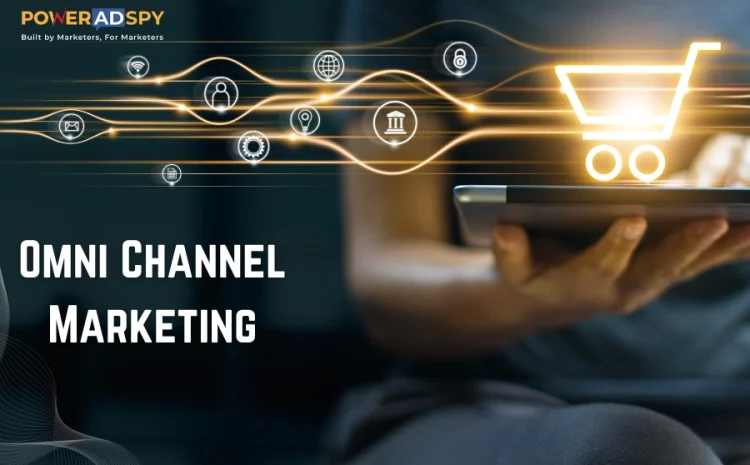The Ultimate Guide To Omni Channel Marketing
Is your marketing strategy drowning in disconnected channels? If Yes, then it is time for you to try Omni channel Marketing!
Imagine this: a customer discovers your eye-catching social media ad, becomes intrigued by a personalized email offer, and then seamlessly completes their purchase on your mobile app. Sounds like a marketer’s dream, right? It proves how effective seamless marketing is.
Gone are the days when marketing efforts operated in isolation, each channel acting independently. Today’s tech-savvy consumers navigate a complex web of touchpoints—social media, email, websites, physical stores, and more. Regardless of where or how customers interact with your brand, they expect a unified and seamless experience.
With the advancement of technology, it is not just how customers shop that has changed, but also how companies market themselves.
This comprehensive guide is your one-stop shop to unlock the secrets of winning seamless marketing. In this blog, we will discuss seamless marketing’s “why” and “how” for enhancing sales, engagement, and brand loyalty.
What Is Omnichannel Marketing?
Omni channel marketing is designed to enhance customer experience by seamlessly integrating branding, ads, messaging, and all possible touchpoints throughout the customer journey.
It focuses on the customer, utilizing traditional and digital channels to maintain a consistent brand experience across all touchpoints. The goal is to enable seamless interactions with a brand across various platforms, such as websites, apps, physical stores, email, social media, and mobile. This ensures that the experience adapts to the customer’s journey and remains consistent at every engagement point.
Seamless marketing ensures all touchpoints are interconnected. This way, customers can move smoothly through the funnel, experiencing consistent branding at every stage.
Why Is Omni Channel Marketing Important?
For a company to succeed in today’s highly competitive market, omni channel marketing is the key factor that helps businesses attract and retain customers. They must deliver a cohesive omnichannel experience driven by customer needs. The customer should be able to experience a seamless journey, regardless of the channel or route they choose.
One customer might take the search engine – landing page – product – checkout path, while another might go from an Instagram ad to a Facebook Messenger chatbot to the product page. An omnichannel experience ensures both journeys offer the same excellent customer experience.
Here are a few pointers depicting the importance of Omni channel marketing.
Cost Efficiency and ROI:
Integrating all channels through seamless marketing enhances ROI and reduces costs by streamlining marketing efforts. A unified approach eliminates redundancies and leverages data-driven insights to optimize your mobile advertising campaigns. This efficiency ensures that marketing budgets get utilized effectively, targeting the right audience with the right message at the right time, leading to better returns on investment and overall cost savings.
Boosting Customer Loyalty:
Omni channel marketing significantly increases customer loyalty by providing a seamless and consistent experience across all touchpoints. Personalized customer interaction and a unified brand presence make them feel valued and understood. This consistency builds trust, encourages repeat business, and fosters a deeper emotional connection with the brand, ultimately leading to long-term loyalty and advocacy.
Building Stronger Customer Relationships:
Seamless marketing enhances a brand’s ability to connect with customers at every stage of their journey, fostering stronger relationships. By providing consistent and personalized experiences across all touchpoints, brands can better understand customer needs and preferences, respond more effectively, and create meaningful interactions that build trust and loyalty over time.
Increasing Customer Lifetime Value (LTV):
Delivering a superior experience through omni channel marketing encourages repeat business, boosting customer’s lifetime value (LTV). By offering uniform, personalized engagements and effortless transitions across every interaction point, customers tend to stay engaged and content. The heightened satisfaction fosters loyalty and encourages customers to make repeat purchases, enhancing their overall value to the brand.
Expanding Customer Reach:
Seamless marketing expands customer reach by combining push strategies, such as targeted ads, with pull strategies, like SEO. This dual approach ensures the brand is visible to potential customers actively searching for solutions and those passively discovering products through eCommerce ads. Brands can attract a wider audience and drive more traffic to their channels by being present across various platforms.
The omni channel marketing strategy allows brands to step into the customer’s shoes and create a journey map, identifying how to better serve their needs at every touchpoint.
An ad analysis tool like PowerAdSpy can also help you craft ads that target your target audience. The tool uses its analytics to filter users and help you boost your conversions through attractive ads. You can also analyze the ads of your competitors and craft ads with their targeting strategies, thus saving you both time and effort. Since it is such a beneficial tool, let us learn about it too.
PowerAdSpy- The Premier Ad Analytics Tool
PowerAdSpy is the best display ad spy tool designed to help advertisers enhance their ad campaigns by providing insights into competitors’ strategies within a specific niche. It analyzes various ad types, copies, and visuals to identify top-performing ads, saving time and effort in campaign creation.
Key Benefits of PowerAdSpy:
Gain Insights: Understand successful ad strategies in your niche by reviewing ad types, copies, and visuals.
Stay Competitive: Adapt your marketing strategies based on competitor insights to improve profitability.
Target Identification: Pinpoint the specific campaign targets using insights from competitor ads.
Niche Research: Conduct thorough niche research for strategic planning and campaign optimization.
With over 500 million+ ads and 250 new ads added daily, PowerAdSpy is essential to streamline your ad creation process and stay ahead in your marketing efforts.
How Is Omni-Channel Marketing Different From Multi-Channel Marketing?
While often needing clarification, there is a significant distinction between omni channel marketing and multi-channel marketing.
Multi-channel marketing involves having a presence across multiple channels.
In contrast, seamless marketing focuses on delivering a seamless customer experience across all engagement channels. It goes beyond mere presence to ensure a consistent brand experience, regardless of how or where customers interact with the business.
For instance, a sustainable fashion brand selling primarily online may maintain social media, a blog, and an e-commerce site. It varies from multiple-channel marketing as it has integration and mutual support from all the platforms.
In contrast, seamless marketing for the same brand would create a unified customer journey, featuring consistent branding elements like color schemes and messaging across all channels.
This strategy seamlessly links each touchpoint, enabling customers to transition effortlessly from social media engagement to purchase from the website and vice versa.
Features Of Omni Channel Marketing
Seamless marketing prioritizes the customer experience by leveraging various communication channels to deliver a cohesive, personalized, and uninterrupted customer journey.
Key features of this strategy include:
Data-Driven Approach:
Seamless marketing harnesses data extensively to understand customer behaviors and preferences. Analysis of this data allows businesses to craft tailored content and select the most effective channels.
This approach enhances engagement by delivering relevant messaging and ensures that marketing efforts are optimized to meet the evolving customer needs and expectations across all touchpoints.
Customer-Centric Approach:
Seamless marketing places the customer journey at its core, striving to comprehend and fulfill the unique path of each customer. This approach delivers personalized, consistent experiences across all touchpoints, making sure interactions match individual preferences and behaviors.
It enhances customer satisfaction and strengthens brand loyalty by consistently meeting customer expectations throughout their journey.
Tracking And Measurement:
Omni channel marketing relies on detailed tracking of customer interactions across all channels. This meticulous monitoring enables businesses to gather valuable data on customer behavior, preferences, and engagement patterns.
By analyzing this data, marketers can strategically deploy tailored promotions and targeted content, optimizing their marketing efforts to deliver relevant messaging that resonates with customers at various stages of their journey.
Integrated Channels:
Seamless marketing integrates many interconnected channels to ensure a seamless customer experience. Businesses develop a holistic understanding of each customer by leveraging data from these channels.
This comprehensive view enables personalized interactions and tailored marketing strategies that resonate across multiple touchpoints, enhancing engagement and fostering long-term customer relationships built on consistency and relevance.
Holistic Approach:
Seamless marketing considers all possible customer touchpoints and how they interact, seamlessly integrating these elements to craft a unified and seamless customer experience journey.
This approach ensures that the customers experience consistent messaging, personalized interactions, and smooth transitions. By addressing every facet of the customer experience, this form of marketing aims to enhance satisfaction, loyalty, and overall brand perception.
But with all these features, how beneficial is this strategy for marketers? Let us learn about its benefits.
Is Omni-Channel Marketing Beneficial?
Nowadays, customers live in a world where online and offline experiences blend together. This integrated lifestyle creates many opportunities for companies to connect with them at various touchpoints. With an omni channel marketing strategy, marketers gain the upper hand due to its benefits. Some of its advantages are:
Streamlined Customer Journey:
Seamless marketing streamlines the path to purchase by consolidating various channels into a cohesive experience. This consolidation eliminates redundancy and confusion, allowing customers to navigate seamlessly from awareness to purchase.
Omnichannel strategies enhance convenience and satisfaction by offering consistent messaging and easy transitions between online and offline touchpoints, ultimately improving the overall customer experience.
Enhanced Loyalty and Retention:
Businesses foster stronger customer loyalty and higher retention rates by delivering a superior overall experience through seamless marketing. When customers consistently encounter seamless interactions and personalized service across all channels, they develop a deeper connection with the brand.
This positive experience builds trust and encourages repeat purchases, ultimately increasing customer lifetime value and solidifying the brand’s position in the market.
Consistent Customer Experience:
Omni channel marketing tackles the challenge of maintaining consistency across diverse channels by orchestrating a unified message at every customer touchpoint. This approach ensures that whether the customer engages through social media, a website, or in-store, they receive cohesive brand messaging and experiences.
By delivering seamless interactions, omnichannel strategies enhance customer satisfaction and reinforce brand identity, fostering trust and loyalty.
Enhanced Channel Coordination:
Seamless marketing transforms disjointed and poorly coordinated marketing channels into a cohesive and integrated system. By aligning messaging, strategies, and customer interactions across all channels—whether digital, physical, or hybrid—businesses create a seamless brand experience.
This integration ensures that every channel complements others, maximizing effectiveness and coherence in reaching and engaging customers consistently throughout their journey.
Increased Return on Investment (ROI):
Adopting an omnichannel approach results in higher ROI by optimizing marketing efforts to be more precise and impactful. By leveraging data-driven insights from various channels, businesses can allocate resources more effectively, target the right audience with personalized messaging, and streamline customer acquisition and retention strategies.
This strategic alignment enhances campaign effectiveness, driving greater returns from marketing investments.
Data-Driven Insights:
Omni channel marketing hinges on thorough data collection and analysis from all channels to guide strategic decision-making. Businesses gain valuable insights into consumer behavior, preferences, and trends by gathering and interpreting customer data across digital, physical, and other touchpoints.
This information empowers marketers to optimize campaigns, personalize customer experiences, and anticipate future needs, ultimately driving more informed and effective business strategies.
Holistic Channel Management:
Seamless marketing demands businesses to integrate each channel seamlessly into a unified strategy. This approach ensures that every customer touchpoint, whether online, offline, or hybrid, aligns cohesively with the brand’s identity and objectives.
By optimizing channel performance through consistent messaging and seamless transitions, businesses enhance overall customer satisfaction and loyalty while maximizing the impact and effectiveness of their marketing efforts across all platforms.
With all these benefits, marketers can utilize this strategy and make their marketing strategy reach their targeted customers effectively. But all good things have a side that makes it challenging. Similarly, an omnichannel marketing strategy too has some challenges. Let us go through them.
Also Read:
8 Latest Digital Advertising Trends That Will Dominate in 2024!
07 Ultimate Strategies For Mobile Advertising Campaigns This Diwali Season
Top 7 Techniques To Do eCommerce Advertising
Challenges In Omni-Challenge Marketing
Implementing an omni channel marketing strategy poses several challenges, despite its benefits. They are:
Unpredictable Customer Behavior:
It allows customers to switch between channels freely, making it challenging for businesses to anticipate their behavior. Businesses tackle this by utilizing data and analytics to monitor customer interactions across every point of contact.
Integration Issues:
Seamless marketing hinges on seamlessly integrating all channels, which can be complex, especially for businesses with diverse channel ecosystems.
Data Utilization Challenges:
Effective personalization relies on collecting and leveraging data efficiently, a hurdle for businesses in data management.
Isolated Result Analysis:
Measuring the success of omnichannel campaigns can be problematic if results are calculated in isolation. Businesses must adopt a holistic approach to evaluate campaign effectiveness across all channels.
Strategic Execution:
You require careful planning and precise execution to execute a successful omnichannel strategy. Businesses must carefully assess their entire ecosystem to ensure readiness and alignment before adopting an omnichannel approach.
But, with these challenges, this strategy ultimately proves beneficial. Let us look at a few examples of how it benefits marketers.
Examples Of Omni-Channel Marketing
Omni channel marketing has gained popularity as businesses increasingly depend on digital advertising trends and channels to connect with their audiences. Numerous industries have successfully adopted omnichannel strategies to enhance customer engagement and satisfaction.
Here are a few examples of it:
Retailers:
Customers enjoy a seamless online, in-store, and mobile shopping experience from retailers such as Target and Walmart.
They also maintain cohesive brand messaging through a robust social media presence.
Banks and Financial Institutions:
Institutions such as Chase and Citibank utilize this form of marketing to serve customers through online and offline modes, mobile apps, SMS, and messaging platforms like WhatsApp. This approach enhances convenience and ensures consistent user experiences tailored to customer preferences.
Transportation:
Uber employs omnichannel tactics to promote its services through digital and offline channels, ensuring broad customer reach and engagement.
Food and Beverage:
McDonald’s exemplifies this form of marketing with an integrated presence across its website, app, social media platforms, and partnerships with influencers, catering effectively to diverse customer needs and preferences.
Conclusion
To conclude, omni channel marketing revolutionizes how businesses engage with customers across every interaction point. Personalized experiences are created by seamlessly integrating online and offline channels. Happy customers fuel business success by becoming loyal advocates.
While understanding customer behavior and integrating diverse channels pose challenges, the rewards are substantial: enhanced brand loyalty, consistent messaging, and optimized marketing spending.
In this interconnected world, seamless marketing meets customer expectations for a cohesive journey, leveraging data to forge enduring connections and secure ongoing success. It is not just a strategy- it is the future of customer engagement.
FAQs
Is Omni Channel Marketing Effective?
Yes, it is effective as it improves customer service scores by allowing support agents to see all customer interactions in one place, like a CRM system or customer service platform, regardless of the channels customers use.
What Are The 4 Cs of Omni Channel Marketing?
In omni channel marketing, the core components are Customer Experience, Context, Content, and Collaboration. Customer experience ensures seamless interactions, while Context tailors messages to individual needs. Content engages across channels, and Collaboration integrates efforts for consistency. They form a cohesive strategy that enhances brand engagement and customer satisfaction.
Does Omni Channel Marketing Improve Sales?
The omni channel approach empowers businesses to gather insights into customer preferences and behaviors across various channels. By analyzing this data, companies can tailor their content and promotions to resonate with customers, driving engagement and encouraging shopping activities, whether online or in physical stores.
















